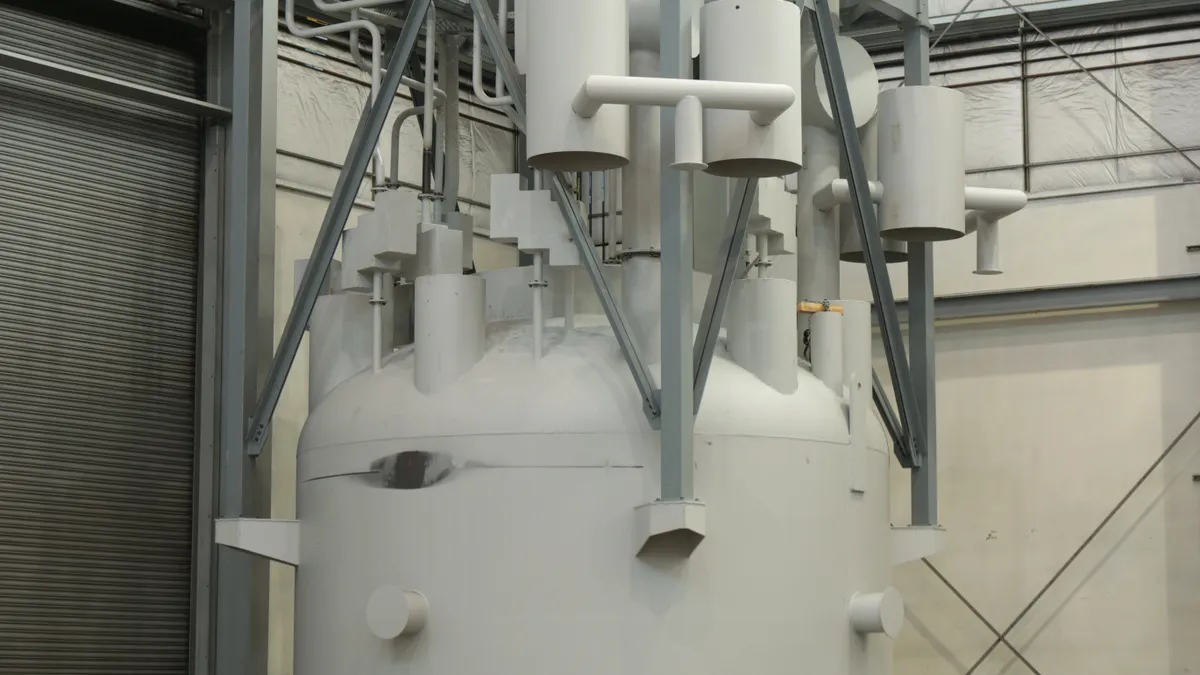Dive Brief:
-
The Nuclear Regulatory Commission (NRC) released a final safety evaluation report on Friday for NuScale Power's small modular reactor (SMR) design. The NRC's staff determined that the design met all the safety requirements for the design certification stage of licensing.
-
The design approval is the first issued for a U.S. small modular reactor, representing a milestone for the entire industry, Marc Nichol, senior director of new reactors at the Nuclear Energy Institute (NEI), said in an email.
- But the reliance on passive safety features is an area of concern for Edwin Lyman, director of nuclear power safety at the Union of Concerned Scientists (UCS), who said the design approved by NRC is different than what the company plans to sell to utilities.
Dive Insight:
NuScale's customers can move forward with plants, knowing that the NRC has approved the safety aspects of the company's design.
The NRC issued a safety evaluation for a 50-Megawatt (MW) module design submitted as part of NuScale's SMR design certification application at the end of 2016. The design uses "passive" processes of gravity and convection, instead of pumped coolant, said Chris Colbert, NuScale's chief strategy officer. By using natural circulation, a reactor could be shut down without water, power or intervention from a computer or operator in the event of an emergency, he said.
The NRC staff concluded the passive processes would ensure the nuclear power plant would shut down safely and remain safe under emergency conditions.
NuScale intends to apply in 2022 for a standard design approval of a 60-megawatt-per-module version of the design, according to the NRC. That version will require additional review from the federal regulators.
NuScale's first plant — a dozen 60 MW modules capable of generating 720 MW – would be deployed at the Department of Energy's Idaho National Laboratory (INL) for the Utah Associated Municipal Power Systems (UAMPS), Colbert said. NuScale will provide the 12 SMRs and Fluor, NuScale's majority shareholder, would be the prime contractor for construction of the facilities. UAMPS has an option to retain Energy Northwest, a consortium of public power utilities, as the plant's operator, according to Colbert.
“In October, UAMPS will begin a new development phase focused on preparation of the combined operating and construction license application,” a spokesperson for UAMPS said in an email. "The first NuScale module is scheduled to be operational at INL in mid-2029, with the 11 other modules operational in 2030."
But "the design that is being certified is not the same design that NuScale actually intends to sell to utilities," UCS's Lyman said.
"NuScale places a lot of faith in the ability of its reactor to be able to safely shut down 'passively,' that is, without the need for motor-driven systems to pump cooling water," he continued.
SMRs can only achieve cost savings in generating electricity by cutting corners and stripping out safety features currently required of nuclear reactors, Lyman said. "NuScale has been aggressively pursuing such cost-cutting measures by seeking exemptions from critical safety and security regulations, and the NRC has for the most part given NuScale everything it has wanted," according to Lyman.
NuScale, which did seek exemptions from regulations developed for large reactors, successfully demonstrated to the NCR that its plant offers safety advantages over active designs used in large reactors, a company spokesperson responded.
“Because the current regulations are premised on large active designs, each of these innovations required exemptions, and result in a much safer design,” according to NuScale.
Increasing the generating capacity of each module from 50 to 60 MW represents a 20% increase and could have major safety implications, according to Lyman.
The power uprate for NuScale's SMRs takes advantage of large margins in the existing design and does not have any major safety implications, according to a company spokesperson.
Lyman also said NuScale's SMRs would be too expensive for a private utility to finance on its own and would require the U.S. government to pay a substantial part of the capital cost.
"NuScale expects that its SMR plants will be at a competitive price point and economic value, allowing its utility and municipal owners to access their traditional forms of project financing," a company spokesperson said in response.
The plant at INL have projected cost of $55 per MWh, making SMR generation competitive with natural gas, according to UAMP's spokesperson.
Cost has been a perennial concern for new nuclear power, but the industry continues to highlight its zero emissions attributes in pushing for more plants.
Nuclear plants can insulate communities and ratepayers from the price fluctuations of natural gas, NuScale's Colbert said. "Nuclear complements solar and wind; having a clean energy system with all three provides you the lowest cost solution."
SMRs will play an important part in achieving net-zero emissions in the United States by 2050 and nuclear power represents the perfect complement to wind and solar power, according to NEI's Nichol.
"Nuclear power reactors bring the highest levels of reliability, can operate 24/7, 365 days a year, integrate seamlessly with renewables, match electricity output with demand, and can be used for heat, desalination and other applications," Nichol said.
"SMRs are being developed with enhanced safety features that will reduce their risks and allow them to be located closer to population centers, potentially reusing retired fossil fuel sites," he continued.
However, communities near an SMR would face undue risk, according to USC's Lyman.
"NuScale wants to be able to build its reactors without any provisions for off-site emergency evacuation planning," he continued, "and it wants to use fewer reactor operators to run its plants and fewer security guards to protect them from terrorist attacks."













